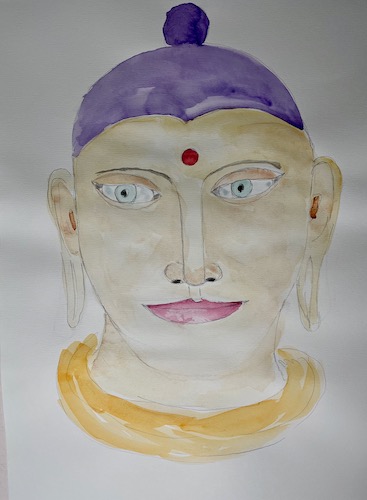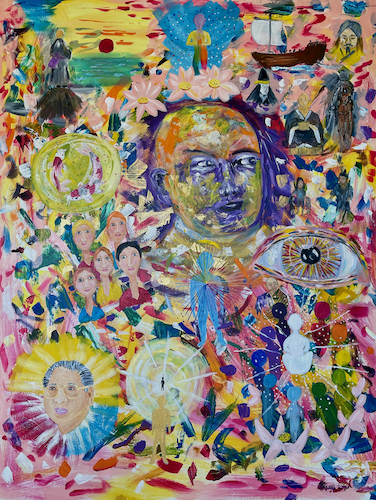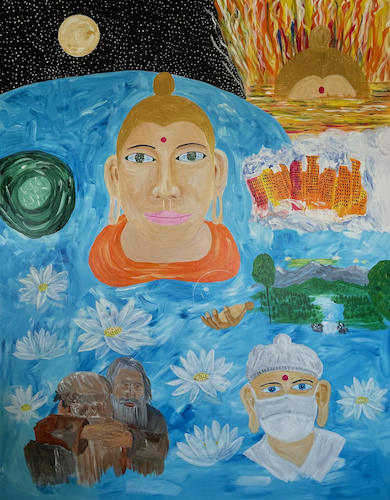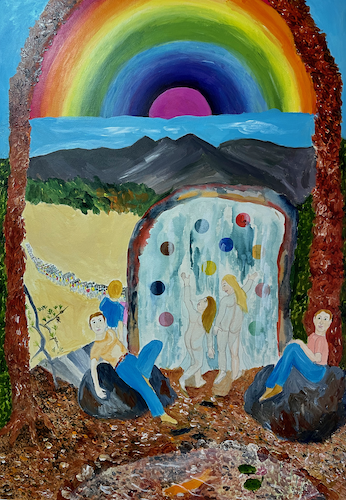zichi Lorentz
![]()
Zichi Lorentz.
Visual Artist.Commentator-Publisher.
Liverpool UK (1952-1971).
London UK (1971-1994).
Japan (1994-).
Present location:Tatsuno City. Hyogo.

SITE UPDATE March 2025

Buddha. Watercolor study
Nichiren Daishonin Japanese Buddhist Monk
Brief Outline of Nichiren Daishonin (1222–1282)
1. Early Life and Studies
Born in 1222 in Japan (Awa Province, present-day Chiba Prefecture). Entered Buddhist priesthood at age 12 and studied various Buddhist schools, including Tendai, Zen, Pure Land, and Shingon.
2. Establishment of Nichiren Buddhism
In 1253, he declared the Lotus Sutra as the supreme teaching and chanted "Nam-myoho-renge-kyo" for the first time. Criticized popular Buddhist schools of the time, such as Pure Land Buddhism and Zen, for misleading people. Wrote his treatise "Risshō Ankoku Ron" (Establishing the Correct Teaching for the Peace of the Land) in 1260, urging the government to adopt the Lotus Sutra.
3. Persecution and Exile
Faced strong opposition from religious and political authorities. First exile (1261–1263): Sent to Izu Peninsula. Tatsunokuchi Persecution (1271): Almost executed but miraculously survived. Second exile (1271–1274): Banished to Sado Island, where he wrote many of his most profound letters and treatises.
4. Later Years and Legacy
Pardoned in 1274 and spent his final years at Mount Minobu, writing and training disciples. Passed away in 1282 in Ikegami, Tokyo. His teachings led to the formation of various Nichiren Buddhist schools, including Nichiren Shoshu and Soka Gakkai in later centuries.
Key Teachings
Nam-myoho-renge-kyo: Chanting this phrase is the essence of attaining enlightenment.
The Three Great Secret Laws: Focus on the Gohonzon (object of devotion), Daimoku (chanting), and Kaidan (place of practice).
Kosen-rufu: The propagation of the Lotus Sutra for world peace.
Nichiren Daishonin is regarded as the Buddha of the Latter Day of the Law, emphasizing personal empowerment and the direct attainment of enlightenment through faith in the Lotus Sutra.
Video Nichiren Daishonin Major WritingsSoka Gakkai Nichiren Buddhism Library
Welcome to the Soka Gakkai Nichiren Buddhism Library. The library contains the following English translations of the essential texts of Nichiren Buddhism: The Writings of Nichiren Daishonin, volumes 1 and 2 (WND-1 and WND-2), The Lotus Sutra and Its Opening and Closing Sutras (LSOC), and the Lotus Sutra commentary The Record of the Orally Transmitted Teachings (OTT). To assist in the study of these works, we also offer The Soka Gakkai Dictionary of Buddhism.
buddhability
Buddhability is an ability we all have within ourselves to change our lives.
Nichiren Daishonin Major Writings
Nichiren Daishonin wrote many articles to his disciples and others. These writings (referred to as the Gosho,
literally “honorable writings”) comprise letters he wrote to his disciples as well as treatises and doctrinal interpretations.
The following are considered to be his ten major writings.
Nichiren Daishonin Ten Major Writings
- 1. Daimoku of the Lotus Sutra 1260
- 2. On Establishing The Correct Teaching for the Peace of the Land. 1260
- 3. The Opening of the Eyes 1272
- 4. The True Object of Devotion 1273
- 5. Choosing the Heart of the Lotus Sutra 1274
- 6. The Selection of Time 1275
- 7. Repaying Debts of Gratitude 1276
- 8. Four Stages of Faith, Five Stages of Practice 1277
- 9. Letter to Shimoyama 1277
- 10. Questions and Answers on the Object of Devotion 1278
Buddhist Paintings
In 1994-97 I painted six large watercolors on the Life of Nichiren. I submitted them in Japan to the 1995 27th Daisan Bunmei exhibition. They were accepted and I received an award. One painting was chosen for the exhibition poster. Held at the Fuji Art Museum. Daisaku Ikeda president of the SGI installed them in the SGI International Friendship Hall Tokyo.
In 1997, I made a large painting on silk 200cm x 200cm, Four Seasons of the Lotus Sutra. Daisaku Ikeda awarded me a Study Fee Award, he also installed the painting in the International Friendship Hall Tokyo.
In 2023, I decided to make a new single large painting on the Life of Nichiren. Acrylic on a wood panel 112 cm x 145cm. The work is about Nichiren and his Ten Major Writings. I started the painting in June 2023 and worked every day until June 2024. The painting required hours of study of Nichiren's writing.
Daisaku Ikeda president of the SGI
I painted 10 watercolor sketches on the Nichiren's Major Writings. This is a gallery of those watercolors.
Buddhist Paintings
Lotus Sutra and the Seven Parables
In June 2024 after the completion of the Nichiren painting I started one on the Lotus Sutra and the Seven Parables.
The time scale was shorter and was completed by August
The Lotus Sutra (Saddharma Puṇḍarīka Sūtra) is one of the most important and influential scriptures in Mahayana Buddhism.
It emphasizes the universal potential for enlightenment and the unity of all Buddhist teachings.
The Lotus Sutra is celebrated for its optimistic message that everyone can attain Buddhahood and for its
emphasis on compassion, wisdom, and skillful means. It has profoundly influenced Buddhist traditions,
particularly in East Asia, where it is central to schools like Nichiren Buddhism and Tendai.
The painting is acrylic on wood and measures 145 cm x 112 cm
Seven Parables of the Lotus Sutra
1. Parable of a Burning House.
2. Parable of the Father and His Lost Son.
3. Parable of the Medicinal Herbs.
4. Parable of the Imaginary City.
5. Parable of the Jewel in the Robe.
Buddhist Paintings
Ten Worlds
The Ten Worlds in the Lotus Sutra are a Buddhist concept that describes ten states of existence, ranging from the lowest suffering to the highest enlightenment. These states are not separate realms but conditions that we can experience moment to moment in life.
Here are the Ten Worlds:
- 1. Hell (Jigoku - 地獄) – A state of suffering, despair, and extreme pain, often brought by anger, hatred, or deep loss.
- 2. Hunger (Gaki - 餓鬼) – The world of insatiable desire, greed, and craving, whether for food, wealth, power, or pleasure.
- 3.Animality (Chikushō - 畜生) – The world of instinct-driven behavior, ignorance, and survival at any cost, ruled by fear and submission to the strong.
- 4. Asura (Shura - 修羅) – The state of conflict, anger, and competitiveness, where one constantly struggles against others and seeks dominance.
- 5. Humanity (Ningen - 人間) – The world of basic rationality and calm, where one can make choices with self-awareness, but still limited by impermanence.
- 6. Heaven (Ten - 天) – A temporary state of pleasure, happiness, and bliss, often due to good karma, but fleeting and not true enlightenment.
- 7. Learning (Shōmon - 声聞) – The world of seekers who pursue knowledge and personal growth through study and discipline.
- 8. Realization (Engaku - 縁覚) – The state of awakening through deep contemplation of nature and life's impermanence, often through personal experience.
- 9. Bodhisattva (Bosatsu - 菩薩) – The world of compassion, where one dedicates themselves to helping others reach enlightenment.
- 10. Buddhahood (Butsu - 仏) – The highest state, where one attains true enlightenment, boundless wisdom, compassion, and freedom from suffering.
The Concept of Mutual Possession of the Ten Worlds Each of these ten worlds contains all ten within it, meaning that a person in any state has the potential to shift to another. For example, even in deep suffering (Hell), one can awaken to Buddhahood. This idea emphasizes that enlightenment is always accessible.
Additional page on the Ten Worlds of BuddhismTen Worlds Buddhist Dictionary


